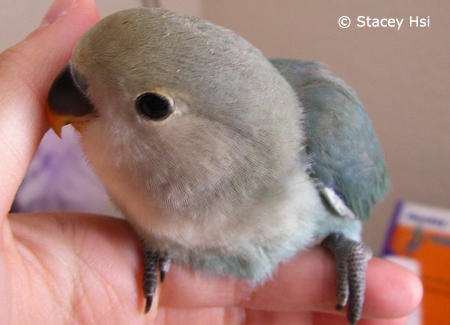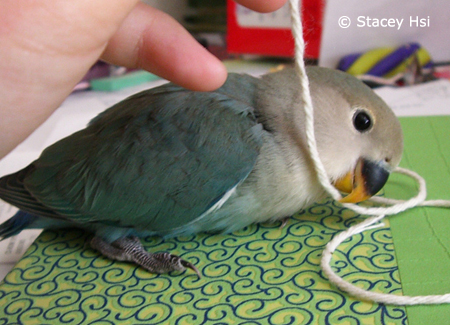Lovebird Weaning

Weaning Lovebird Babies can be a stressful event for both the breeder and baby. At around five weeks, most baby lovebirds start to refuse their formula. It is common for lovebird breeders to become worried as the babies begin to eat less and less and not accept the food that is given. When this food-refusal time begins, most baby lovebirds will taste the formula once or twice and then let it run through their beaks as it drips down. This sudden change in behavior seems unusual but is really quite normal. New breeders may not be aware of this because they expect the baby chicks to continue eating the same amounts of food until fully weaned. This behavior should be expected as the time nears for the weaning lovebird babies to fledge (leave) the nest.
During this time when the lovebirds start to show signs of weaning, the owner should not force the baby parrots to eat. Instead, the baby lovebirds should be allowed to eat as little as they want. The mistake that some breeders make is to offshoot this refusal of food by sometimes starving the babies in the hopes that they will eventually eat when provided with food. This will not work because many chicks will starve rather than eat during this time. The best approach is to provide small feeds throughout the day; thereby, allowing the baby chicks to get enough small doses of formula so that they don’t starve.
A small scale can be used to monitor the weight of the chicks to be sure they are not getting too thin. The chicks should drop no more than five to seven grams of weight. If a baby seems to be lethargic or completely refuses hand feeding formula, the breeder should call their veterinarian immediately as the bird might have other ailments that need to be addressed. Sometimes a sour crop or a bacterial infection can cause a chick to not eat.
New Foods For Weaning Lovebirds
When the babies are all feathered out and start exploring their brooder, this is usually a great indicator they are almost on the cusp of weaning. This is also a great time to introduce new foods into their diet. Daily, new food items such as vegetables, fruits, pellets, and seeds should be given. The more the birds are exposed to a varied diet, the more they will enjoy many foods as adults. In the beginning, the birds might not show any interest in the foods placed inside the brooder but eventually curiosity will win out. Before long, they will be nibbling on the new foods, which will eventually lead to them fully eating the foods. This constant exposure will help develop a confident adult bird that will not be picky.
A great way to introduce pellets to the weaning lovebirds is to place a bowl next to the food dish or water dish and eventually the bird will become curious and will begin tasting it. Including softer foods is also crucial. Things such as apples, pears, or mangos are great. During the noon, incorporate vegetables such as shredded carrots, squash, or zucchini. For a later meal, you may want to give the birds some millet, pellets, corn, brown rice, or lentils. It’s the variety that is important for your pet to get all the necessary nutrients to keep him healthy.
It is important all foods be removed no more than three hours after being introduced. Any longer, the food will become rancid and this could lead to more complications. It is also important each food item have a different texture, color, and taste.
Encouraging weaning
Though the process of weaning might seem lengthy, it really is not a long process in the grand scheme of a lovebird’s life. The window at which the lovebird weans is around three to four weeks. This is normal for most lovebirds but some can take longer. It is important the baby never be starved in hopes that it will eat on its own. This dated method only creates babies who become thinner, weaker, less confident, and a longer weaning period is usually the outcome and also death from starvation. Babies who are starved spend most of their time stressed about their next meal and beg and cry most of their time rather then explore and try new foods.
If a baby lovebird should take longer than eight weeks to wean, the breeder can try using soft warm foods to help convert the bird over to solid foods. Almost always, warm foods will trigger a feeding response. Taking small chunks of food between the breeder’s fingers will most certainly make the baby interested. Most baby lovebirds will investigate this and try to nibble on the food. Additionally, fresh pumpkin, squash, beans, or broccoli should also be provided.
Don’t Send The Baby Lovebird Away Yet!

It’s important the baby lovebird not be sold too soon after weaning. When the lovebird starts to eat on its own, it should be kept a few days to be monitored. In fact, the birds should periodically be spoon or syringe fed even after being fully weaned. This should be done a few times a week by the new owner to ensure the baby doesn’t get sick or need medications. A commercial hand feeding formula is also a great treat for adult birds and is a great way for them to receive extra nutrients.
When do lovebirds finally wean?
Most lovebirds will be weaned by eight weeks; however, some have taken as long as 10 weeks. Every lovebird is different and every bird will wean when it is ready. It is important to note, lovebirds that are kept separated from other birds usually take longer to wean. If this scenario is the case, the key is to have patience and let the lovebird wean when it is ready.




